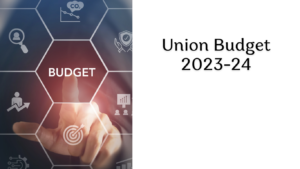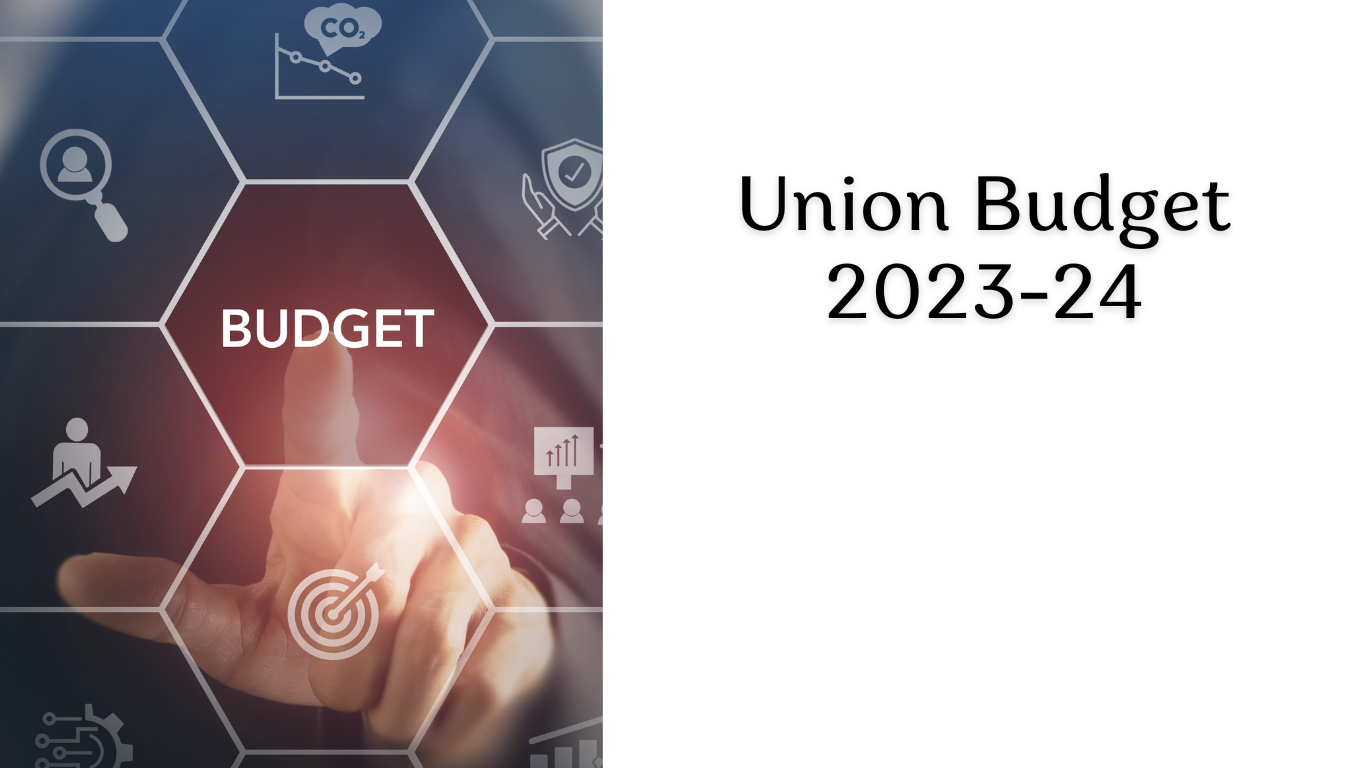Union Budget 2023-24
Union Budget 2023-24 The central government’s spending is outlined and approved by Parliament annually through the Union Budget. According to Article 113 of the Constitution, all expenditures, except for those already earmarked, must be presented as Demands for Grants, organised by the ministry, to the Lok Sabha. These demands are then scrutinized by the respective Departmentally-Related Standing Committees before being deliberated upon and sanctioned by the Lok Sabha. Once the Lok Sabha approves the demands, an Appropriation Bill is introduced and ratified to enable spending from the Consolidated Fund of India.
This document provides a concise analysis of the Union Budget for the financial year 2023-24, along with an evaluation of the allocations assigned to 15 ministries. Union Budget 2023-24 These ministries collectively represent 72% of the entire Union Budget. The analysis encompasses an examination of significant expenditure patterns, an overview of the schemes being executed, and a discussion on critical sectoral concerns.

The Union Budget for the fiscal year 2023-24 was presented on February 1, 2023, by the Finance Minister, Ms. Nirmala Sitharaman. Union Budget 2023-24 The proposed expenditure for the financial year amounts to Rs 45,03,097 crore. Out of this total expenditure, revenue expenditure is projected to be Rs 35,02,136 crore, marking a 1.2% increase from the revised estimates of 2022-23. Interest expenditure constitutes 41% of revenue receipts. Capital expenditure is estimated at Rs 10,00,961 crore, reflecting a substantial 37.4% increase from the revised estimates of the previous fiscal year.
This surge in capital expenditure is primarily attributed to a higher allocation for transport infrastructure and capital loans to states. The targeted revenue deficit for 2023-24 is 2.9% of GDP, which is lower than the revised revenue deficit of 4.1% in 2022-23. Additionally, the fiscal deficit target for 2023-24 stands at 5.9% of GDP, showing a reduction from the revised fiscal deficit of 6.4% in 2022-23.
The Finance Bill of 2023 introduces several alterations to the tax system. The threshold for claiming a rebate and being exempt from taxes has been raised from Rs 5 lakh to Rs 7 lakh. Additionally, the number of tax brackets has been reduced from six to five. Notably, the surcharge for the highest income bracket (earnings exceeding Rs 5 crore) has been reduced from 37% to 25%.
The expenditure highlights of various ministries/departments are as follows:
Defence: The Ministry of Defense has been allocated Rs 5,93,538 crore, the largest allocation among all ministries, representing over 13% of the central government’s total expenditure. However, its expenditure as a percentage of GDP has decreased over the past decade. In 2023-24, its allocation is estimated to be slightly less than 2% of GDP. Since 2014-15, spending on defense pensions has consistently exceeded 20% of the total budget, while the capital outlay has remained below 30% of the budget.
Road Transport and Highways: The Ministry has been allocated Rs 2,70,435 crore, marking a 25% increase from the revised estimates of 2022-23. A significant portion of this additional allocation (60%) is designated for investment in the National Highways Authority of India (NHAI). The budgetary allocation has risen as NHAI will no longer borrow from the market. Road construction is mainly funded through public funds, with private investment contributing only 7% to road investments in 2020-21.
Railways: In the fiscal year 2023-24, Railways is anticipated to achieve a marginal revenue surplus, which would cover less than 1% of its capital expenditure plan. The majority (92%) of the capital expenditure will be financed by budgetary support from the central government, with an additional 7% coming from extra-budgetary resources. The operating ratio, reflecting expenditures relative to traffic works receipts, stands at 98.5%, indicating a limited surplus for capital investment.
Food and Public Distribution: The allocation for the Department in 2023-24 saw a significant decrease of 31% compared to the revised estimate of 2022-23. This reduction was primarily due to the discontinuation of the Pradhan Mantri Garib Kalyan Anna Yojana, which was introduced during the pandemic to provide free food grains to eligible beneficiaries. In 2023-24, expenditure on food subsidy is estimated to be Rs 1.97 lakh crore. Updating the coverage of eligible families remains a challenge as the total number of beneficiaries continues to be based on the 2011 Census.
Home Affairs: The Ministry has been allocated Rs 1,96,035 crore, reflecting a modest increase of 1.1% compared to the revised estimates for 2022-23. Within the Ministry’s total budget, 65% of the expenditure is allocated to police services, while 31% is directed towards grants to Union Territories (UTs). A significant portion (74%) of the expenditure on police is allocated to the Central Armed Police. Key issues in the sector include shortages of police personnel and an inadequate number of cybercrime cells. Additionally, 24% of the Indo-Bangladesh border remains unfenced.
Rural Development: The Ministry of Rural Development received an allocation of approximately Rs 1.6 lakh crore for the fiscal year 2023-24, representing a 12% decrease compared to the revised estimates of 2022-23. This reduction is mainly attributed to the decrease in allocation towards the Mahatma Gandhi National Rural Employment Guarantee Scheme (MGNREGS), with a budget of Rs 60,000 crore, which is 33% less than the revised estimate for 2022-23. It is anticipated that the demand for work under MGNREGA may decline this year as the rural economy returns to normalcy following the pandemic. However, allocation towards rural housing has increased by 13% in 2023-24, while allocation towards rural roads remains unchanged.
Agriculture: Union Budget 2023-24 The Ministry has been allocated Rs 1,25,036 crore for the fiscal year 2023-24, marking a 5% increase compared to the revised estimates of 2022-23. A significant portion, 77%, of the Ministry’s estimated expenditure is directed towards three schemes that offer cash transfers, interest subsidies, and crop insurance. Union Budget 2023-24 Although the amount of institutional credit extended to farmers has increased by 7.8% over the past decade, these loans are predominantly utilised to meet revenue expenditure in farming or recurring household expenses.
Education: The Ministry of Education is projected to have an estimated expenditure of Rs 1,12,899 crore in 2023-24, reflecting a 13% increase from the revised estimates for 2022-23. Within this allocation, the Department of School Education and Literacy has been allocated 61%, while the Department of Higher Education receives the remaining 39%. A significant portion, 33%, of the Union Budget 2023-24 Ministry’s budget is earmarked for the Samagra Shiksha Abhiyan. Since 2015, the overall allocation towards education has hovered around 2.8% of the GDP.
Telecommunications: In 2023-24, Rs 59,740 crore, constituting 56% of the allocation, is designated for the revival package for BSNL and MTNL. No funds were disbursed under the PLI (Production Linked Incentive) scheme in 2021-22, and according to revised estimates, no funds will be allocated to this scheme in 2022-23 either. Projects like Bharatnet and Network for Defence have experienced considerable delays.
Jal Shakti: The Ministry of Jal Shakti has been allocated Rs 97,278 crore for the fiscal year 2023-24, marking a 31% increase over the revised estimates for 2022-23. The Jal Jeevan Mission received the highest allocation of Rs 70,000 crore. Allocation towards River Interlinking has increased due to the implementation of the Ken-Betwa Link Project. However, funds have remained underutilised in schemes such as the Swachh Bharat Mission- Gramin, Atal Bhujal Yojana, and Namami Gange.
Health and Family Welfare: Union Budget 2023-24 The Ministry of Health and Family Welfare is projected to expend Rs 89,155 crore in 2023-24, reflecting a 13% increase from the revised estimates for 2022-23. The National Health Mission constitutes the largest component, comprising 33% of the Ministry’s budget, while medical colleges and hospitals account for 27%. Significant challenges persist, including high out-of-pocket expenditure and a shortage of healthcare personnel.
Housing and Urban Affairs: The Ministry of Housing and Urban Affairs has been allocated Rs 76,432 crore for the financial year 2023-24, representing a modest increase of 2.5% over the revised estimates for 2022-23. Union Budget 2023-24 The major allocations include Rs 25,103 crore for urban housing under the PMAY-U (Pradhan Mantri Awas Yojana – Urban) scheme and Rs 23,175 crore for metro projects. However, several metro systems are struggling to generate the necessary ridership to break even.
Petroleum and Natural Gas: The Ministry has been allocated Rs 41,008 crore, reflecting a 21% increase over the revised estimates for 2022-23. This allocation includes Rs 30,000 crore earmarked for providing capital support to Oil Marketing Companies through equity infusions. There has been a reduction in the allocation for LPG subsidy, and no funds have been allocated for the kerosene subsidy. However, there has been an increase in capital outlay towards the construction of caverns and the procurement of oil for the Strategic Petroleum Reserves.
Women and Child Development: The Ministry has been allocated Rs 25,449 crore for the fiscal year 2023-24, representing a 6% increase compared to the revised estimates of 2022-23. This allocation is distributed across three centrally sponsored schemes: Saksham Anganwadi and POSHAN 2.0, Mission Shakti, and Mission Vatsalya. However, over the past five years, from 2016-17 to 2021-22, the Ministry has consistently underutilised its funds.
Environment, Forests, and Climate Change: The Ministry of Environment, Forests, and Climate Change has been allocated Rs 3,079 crore for the fiscal year 2023-24, marking a 24% increase from the revised estimates of 2022-23. Despite India setting targets to transition to renewable energy to combat climate change, the availability of adequate finance remains a significant challenge. Experts estimate that the overall cost for India to adapt to climate change by 2030 could reach around Rs 86 lakh crore (at 2012 base price).
Sources : https://www.indiabudget.gov.in/
For More Information : https://taxgyany.com/

